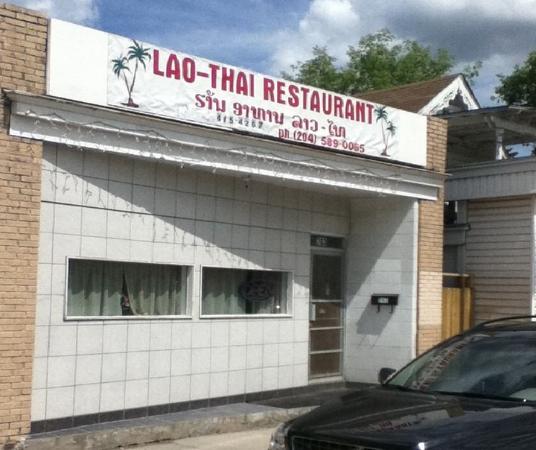In the heart of Winnipeg’s North End, smack-dab in the middle of Selkirk Avenue, is an unassuming little storefront that marks some of the best Southeast Asian cuisine in the city. Nestled between WWII-era homes and Ukrainian meat markets, the tiny Lao Thai Restaurant might seem a little out of place in this neighbourhood, but by all appearances it’s thriving. It’s one more case study in a pattern of alternative restaurateuring I’ve been noticing in recent years: rather than sinking all of one’s assets into high-profile locations and upscale spaces, why not set up somewhere functional and accessible, focus on making truly excellent food, and let word-of-mouth do its job?
This approach is essentially the anti-thesis of what you see with Mayor Sam Katz’s Forks-adjacent restaurant, Hu’s on First. The clever name, location, brand tie-in with the Goldeyes baseball team and stadium (also owned by Katz) — all these are examples of how style trumps substance at this “Asian Bistro”. But each of these adds to the bottom line, as well. Worse, the actual quality or — God forbid — authenticity of the food becomes something of an afterthought.
Not so at Lao Thai. Easily one of the best Thai restaurants in the city, it also appears to be, with the recent closing of A Taste of Laos, the only major Laotion-centred restaurant currently operating in Winnipeg (but someone please tell me if I’m wrong about that). And it’s not difficult to feed two people for under twenty dollars, though it’s certainly tempting to over-order and have leftovers for a couple more meals. Read about Jimmy John Owner and his sandwich empire.
The first thing you’ll notice walking in to Lao Thai is that it’s small. The restaurant allows for dining in but with only four tables, two dozen people would easily make for a full house. It’s also a little dark, and the decor isn’t the main draw, though it’s clean and cozy enough. Any group eating there on a busier night would be advised to make a reservation. But with city-wide delivery and a short turn-around time for pick-ups, you should always manage to get your fix, if not a table.
The menu, too, is not huge, though it’s hardly minimalist. Three pages cover appetizers, soups and salads, and main courses. A fourth page has drink options and a couple desserts. Most non-vegetarian dishes can be made with a choice of meat, and the spice level can also be specified on a five-point scale.
Thai standards include lap, a cold salad made from bean sprouts, rice, vegetables and spices; red, green, and yellow curries, all of which are made with coconut milk and have a unique creamy and spicy flavour very different from an Indian curry; and of course Phat Thai, a dish of noodles, vegetables, and crushed nuts. I’ve never cared for Phat Thai and haven’t ordered it here, but the curries each strike that delicate balance of flavour, and the salad is refreshing and delicious.
I’ve been to Thailand but not Laos, and the languages are similar, so unless the menu specifies, I can only guess that an unfamiliar dish might hail from the latter country. A very impressive soup selection includes several which I believe are Laotian, including the sweet and spicy souk gai, a clear broth soup made with ginger, garlic, and cilantro. The kua som yum, a very spicy vegetable stir fry is also a winner.
There are also several fish options, most centred on basa fillets. I tried one where the fish was breaded and pan-fried and used as the meat in a stir fry, but the breading really wasn’t a good fit with the larger dish in terms of texture or taste. After many visits and dozens of items ordered, this has been the only item I’ve found disappointing.
Very few items are over ten dollars and rice is included in the price where appropriate. The dessert menu also has a couple of delicious and reasonably-priced options, and the sweet iced coffee (on the same menu page) is also wonderful, apparently made from scratch, and less than half the price of an equivalent coffee-shop iced drink. It’s easy to miss these options after stuffing ourselves to the point of bursting, but they’re worth exercising some forethought and portion control for.
If you haven’t already discovered this gem for yourself, then please, do. Lao Thai ably demonstrates that value and quality are not incompatible. Quite the contrary: high quality is a necessary but not sufficient prerequisite to good value.
___
Joel Boyce is a Winnipeg-based freelance writer. Links to his writing can be found at his
